
Concept explainers
RECALL Define the following terms: polysaccharide, furanose, pyranose, aldose, ketose, glycosidic bond, oligosaccharide, glycoprotein.
Interpretation:
The given terms are to be defined.
Concept introduction:
A long chain of monosaccharides linked by glycosidic bonds is known as a polysaccharide. A five-membered cyclic ring of sugar is furanose and a six-membered cyclic ring is pyranose. A monosaccharide containing an aldehydic group is called an aldose, and if it contains a ketonic group then it is called a ketose. The hydroxyl
Answer to Problem 1RE
Solution:
Polysaccharide: It is a large molecule made up of a large number of monosaccharides that are bound together with glycosidic linkages.
Pyranose: It is a six-membered cyclic sugar consisting of five carbon atoms along with one oxygen atom.
Furanose: It is a five-membered cyclic sugar consisting of four carbon atoms along with one oxygen atom.
Aldose: It is a monosaccharide (a simple sugar) that contains an aldehydic group
Ketose: It is a monosaccharide (a simple sugar) that contains a ketonic group
Glycosidic bond or glycosidic linkage: It is a type of covalent bond that joins one carbohydrate molecule to another carbohydrate molecule.
Oligosaccharide: It is a saccharide polymer that contains a small number of monosaccharides, typically 3–10 monosaccharides molecules.
Glycoproteins: These proteins consist of oligosaccharides that are covalently attached to proteins (or amino acids).
Explanation of Solution
Given information: Polysaccharides, pyranose, furanose, aldose, ketose, glycoside bond, oligosaccharide, and glycoprotein.
Polysaccharide: It is a polymer that consists of a large number of monosaccharides, typically around 20 or more. They are of two types, namely, homopolysaccharides, which consist of a single type of single monosaccharide unit, and heterpolysaccharides, which consist of different monosaccharide units. For example, glycogen, a homopolysacccharide, forms glucose units.
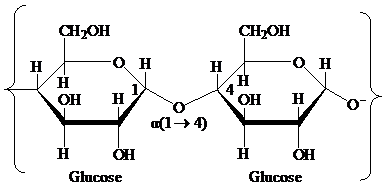
Pyranose: The chemical structure of pyranose contains a six-membered ring, which includes five carbon atoms and one oxygen atom. The formation of pyranose takes place by the reaction of alcoholic group of carbon-5 of an open chain with the aldehydic group of carbon-1 of a similar chain.
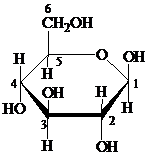
Furanose: The chemical structure of furanose contains a five-membered ring that includes four carbon atoms and one oxygen atom. The formation of pyranose takes place by the reaction of alcoholic group of carbon-4 of an open chain with the aldehydic group of carbon-1 of a similar chain.
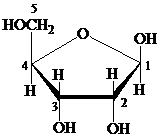
Aldose: This is a class of carbohydrates that has an aldehydic group and is known as polyhydroxy aldehydes. Aldoses are also called reducing sugars for they act as a reducing agent because of the presence of the aldehydic group. They reduce Tollen’s reagent. For example, glucose.

Ketose: This is a class of carbohydrates that have a ketonic group and is also known as polyhydroxy ketones. They are not reducing sugars but they tautomerize themselves to aldoses before acting as a reducing sugar. For example, fructose

Glycosidic bond: It is a covalent bond that joins a carbohydrate to another carbohydrate or functional group of any other molecule. A substance containing a glycosidic bond is called a glycoside. For example, the glycosidic linkage of two glucose molecules is shown in the following figure:
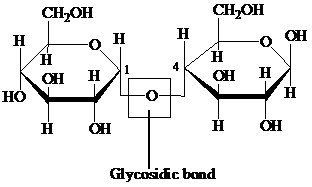
Oligosaccharides: Such carbohydrates contain 3–10 simple sugars that are linked together. They are naturally found in plants and onions. They are soluble fibers and hence easy to digest. Most common examples are sucrose, maltose, and lactose.
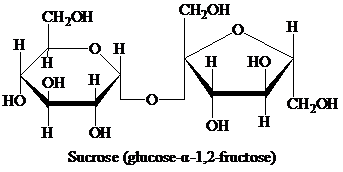
Glycoprotein: It is a type of protein that has a carbohydrate attached to it. This carbohydrate is an oligosaccharide that is covalently attach to a polypeptide chain of protein. It is usually found in aloe vera, brown rice, meat, and so on. They play an important function in the reproduction, immune system, hormone balance, and protection of cells.
All the terms have been defined, along with their structures being described.
Want to see more full solutions like this?
Chapter 16 Solutions
Biochemistry
- please draw it for me and tell me where i need to modify the structurearrow_forwardPlease help determine the standard curve for my Kinase Activity in Excel Spreadsheet. Link: https://mnscu-my.sharepoint.com/personal/vi2163ss_go_minnstate_edu/_layouts/15/Doc.aspx?sourcedoc=%7B958f5aee-aabd-45d7-9f7e-380002892ee0%7D&action=default&slrid=9b178ea1-b025-8000-6e3f-1cbfb0aaef90&originalPath=aHR0cHM6Ly9tbnNjdS1teS5zaGFyZXBvaW50LmNvbS86eDovZy9wZXJzb25hbC92aTIxNjNzc19nb19taW5uc3RhdGVfZWR1L0VlNWFqNVc5cXRkRm4zNDRBQUtKTHVBQldtcEtWSUdNVmtJMkoxQzl3dmtPVlE_cnRpbWU9eEE2X291ZHIzVWc&CID=e2126631-9922-4cc5-b5d3-54c7007a756f&_SRM=0:G:93 Determine the amount of VRK1 is present 1. Average the data and calculate the mean absorbance for each concentration/dilution (Please over look for Corrections) 2. Blank Correction à Subtract 0 ug/mL blank absorbance from all readings (Please over look for Corrections) 3. Plot the Standard Curve (Please over look for Corrections) 4. Convert VRK1 concentration from ug/mL to g/L 5. Use the molar mass of VRK1 to convert to M and uM…arrow_forwardMacmillan Learning Cholesterol synthesis begins with the formation of mevalonate from acetyl CoA. This process activates mevalonate and converts it to isopentenyl pyrophosphate. Identify the atoms in mevalonate and isopentenyl pyrophosphate that will be labeled from acetyl CoA labeled with 14C in the carbonyl carbon. Place 14C atoms and C atoms to denote which carbon atoms are labeled and which are not labeled. H₂C COA 14C-labeled acetyl-CoA HHH [c] H H OH 014C - OH H HH H Mevalonate CH3 H H 14C H Η H H Incorrect Answer of o -P-O-P-0- Isopentenyl pyrophosphate с Answer Bank 14Carrow_forward
- Draw the reaction between sphingosine and arachidonic acid. Draw out the full structures.arrow_forwardDraw both cis and trans oleic acid. Explain why cis-oleic acid has a melting point of 13.4°C and trans-oleic acid has a melting point of 44.5°C.arrow_forwardDraw the full structure of the mixed triacylglycerol formed by the reaction of glycerol and the fatty acids arachidic, lauric and trans-palmitoleic. Draw the line structure.arrow_forward
- Draw out the structure for lycopene and label each isoprene unit. "Where is lycopene found in nature and what health benefits does it provide?arrow_forwardWhat does it mean to be an essential fatty acid? What are the essential fatty acids?arrow_forwardCompare and contrast primary and secondary active transport mechanisms in terms of energy utilisation and efficiency. Provide examples of each and discuss their physiological significance in maintaining ionic balance and nutrient uptake. Rubric Understanding the key concepts (clearly and accurately explains primary and secondary active transport mechanisms, showing a deep understanding of their roles) Energy utilisation analysis ( thoroughly compares energy utilisation in primary and secondary transport with specific and relevant examples Efficiency discussion Use of examples (provides relevant and accurate examples (e.g sodium potassium pump, SGLT1) with clear links to physiological significance. Clarity and structure (presents ideas logically and cohesively with clear organisation and smooth transition between sections)arrow_forward
- 9. Which one of the compounds below is the major organic product obtained from the following reaction sequence, starting with ethyl acetoacetate? 요요. 1. NaOCH2CH3 CH3CH2OH 1. NaOH, H₂O 2. H3O+ 3. A OCH2CH3 2. ethyl acetoacetate ii A 3. H3O+ OH B C D Earrow_forward7. Only one of the following ketones cannot be made via an acetoacetic ester synthesis. Which one is it? Ph کہ A B C D Earrow_forward2. Which one is the major organic product obtained from the following reaction sequence? HO A OH 1. NaOEt, EtOH 1. LiAlH4 EtO OEt 2. H3O+ 2. H3O+ OH B OH OH C -OH HO -OH OH D E .CO₂Etarrow_forward
 BiochemistryBiochemistryISBN:9781305961135Author:Mary K. Campbell, Shawn O. Farrell, Owen M. McDougalPublisher:Cengage Learning
BiochemistryBiochemistryISBN:9781305961135Author:Mary K. Campbell, Shawn O. Farrell, Owen M. McDougalPublisher:Cengage Learning
